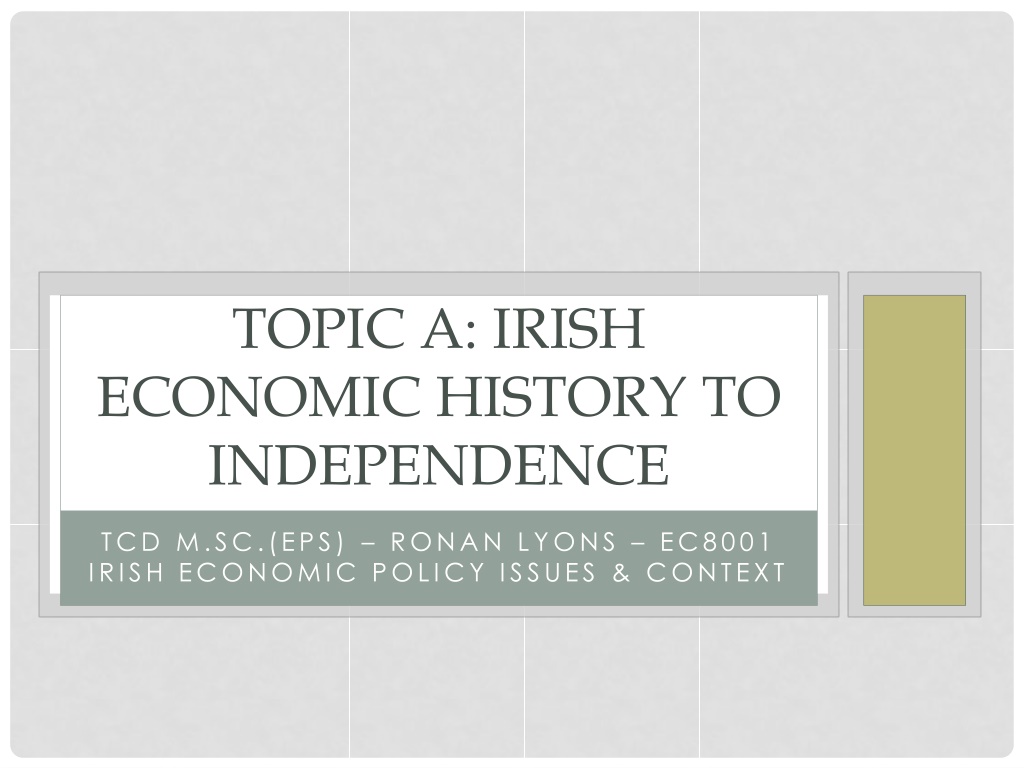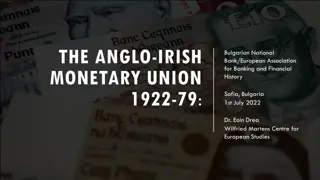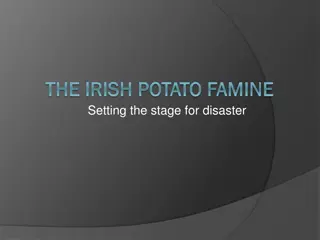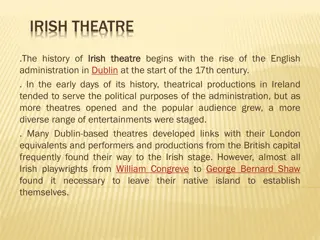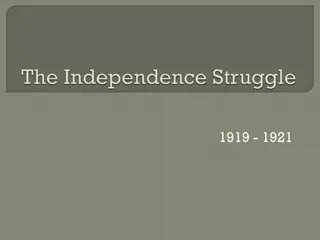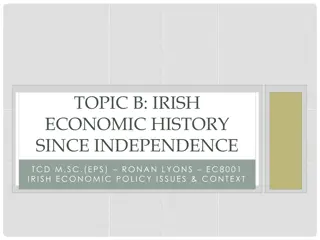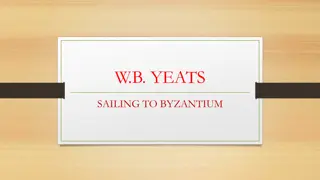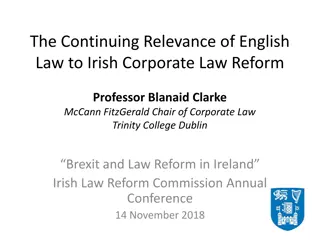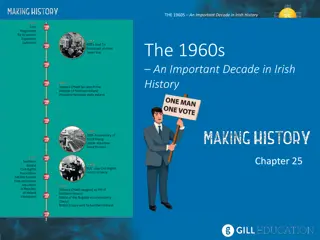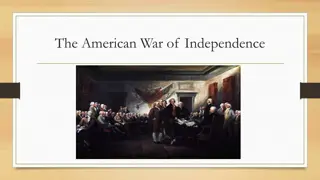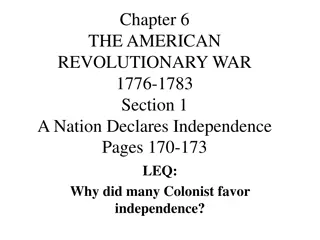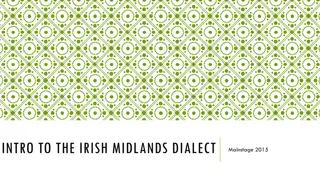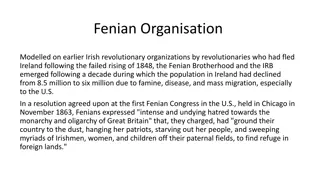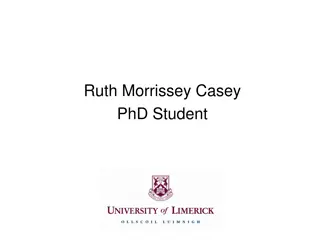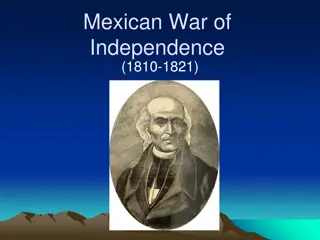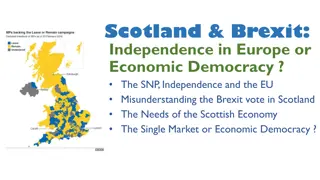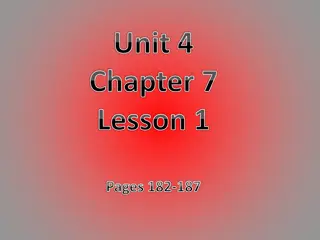Irish Economic History to Independence Overview
Delve into the economic history of Ireland leading up to its independence through topics such as the pre-famine economy, the impact of great famines, role of economists like Adam Smith and Malthus, and the effects of policies like the Corn Laws. Explore key issues like economic growth, public finances, labor market dynamics, social justice, and more.
Download Presentation

Please find below an Image/Link to download the presentation.
The content on the website is provided AS IS for your information and personal use only. It may not be sold, licensed, or shared on other websites without obtaining consent from the author. Download presentation by click this link. If you encounter any issues during the download, it is possible that the publisher has removed the file from their server.
E N D
Presentation Transcript
TOPIC A: IRISH ECONOMIC HISTORY TO INDEPENDENCE TCD M.SC.(EPS) RONAN LYONS EC8001 IRISH ECONOMIC POLICY ISSUES & CONTEXT
MODULE OUTLINE Topic Title A B C D E F G H I J EoI Ch 1+ 1+ 2, 7 3, 4 6 8 5 9, 11 12, 13 10, 14* Dates MT1-2 MT3-4 MT5-6 MT8-9 MT10-11 HT1-2 HT3-4 HT5-6 HT8-9 HT10-11 Irish Economic History to Independence Irish Economic History since Independence The Economy & Economic Growth Public Finances, Debt & Taxation The Labour Market Social Justice & Inequality Regulation & Competition Competitiveness & Trade Health & Education Natural Resources & Real Estate
TOPIC A: STRUCTURE Irish Economic History to Independence 1. Why bother? 2. The Irish Economy before Waterloo 3. From Waterloo to the Great Famine 4. The Great Famine 5. The Post-Famine Economy
IRELAND BEFORE THE FAMINE George O Brien (1921) Joel Mokyr (1983) VS. The destiny of Ireland in the early 19thCentury was very largely moulded by the ideas of two great economists, Adam Smith and Malthus, and of the two, the latter was probably the more influential. At least as far as pre- famine Ireland is concerned, Malthusian models seem to have little explanatory power.
WHY WE BOTHER (REVISITED) Economics, development and famine What can perhaps the world s most famous famine tell us about the economic causes and effects of famine? Remember important distinction between farming class and labourer class Trends for country as a whole may be different to trends for poorest labourer class About 85% living in rural Ireland Slowdown in population growth at odds with idea that Irish procreated oblivious to their hardship 1800-01 and 1817-19 famines saw significant deaths But failures of 1822 and 1830 did not
ROLE OF THE CORN LAWS Per-worker output half of UK higher land/lab ratio Nonetheless, access to same technology, markets? Typical acre rented for ~17s. compared to ~25s. High price of tillage due to Corn Laws saw it spread Longford/Roscommon, Antrim, Clare/W. Limerick/Kerry Grain yields also increased ~20% between 1770s and 1840s UK-wide protection central From 17% of Britain corn imports in 1790s to 80% by 1830s Corn Laws encouraged and reduced the burden of Irish industrial decline after 1815 Led to not only too much tillage, but also too much potato (given its role in rotation)
IRELANDS TRANSPORT BOOM(S) Underpins market economy (like financial services) A mini-boom in road infrastructure & mail coaches Regular Limerick-Dublin service by 1760s, Belfast from 1789 Belfast-Dublin: travel time from 21hrs (1802) to 14hrs (1825) Much less success with canals (vs. Britain) Only 1 of 5 could be deemed a success lack of S or D? Then again, British success down to coal deposits A world leader in ferries & steamships 1818, Belfast-Greenock; by 1836 Dublin to Liverpool, London and Glasgow By 1840s, 100 regular crossing, with intense fare competition Railway mania mid-1840s 17/100 schemes by 1850
TRANSFORMATION OF BANKING Remember: pre-1820s, many small banks Removal of restrictions on # partners, merchants in 1824 1825-45: all of Ireland main s banks (except BofI) Northern Bank, Provincial Bank [landlord bank par excellence], Hibernian (all 1825) National Bank, 1830s [O Connell brainchild and millstone!] Upper and middle class clientele Core business was converting rural deposits into urban commercial loans, typically 1-year Despite competition, high dividends From 5% (Royal, National) to 10% (BofI, Northern) Bank of Ireland still special (LOLR)
CYCLES BUT NO TREND Share price index of Irish banks, 1825-1845 110 105 100 95 90 85 80 1845 1825 1826 1827 1828 1829 1830 1831 1832 1833 1834 1835 1836 1837 1838 1839 1840 1841 1842 1843 1844
FERTILITY BEFORE THE FAMINE Fertility: Evidence from Quakers suggests that marital fertility in Ireland was high but fell between late 1700s and early 1800s Nuptiality: pre-Famine, a high proportion never married (10-12%) Census 1841 implies increasing marriage age during 1830s ~15,000 averted births Measure of fertility 0.41 0.40 0.39 0.38 0.37 0.36 0.35 0.34 0.33 0.32 Ireland 1840s England 1851 Germany 1875 Italy 1865
THE WANDERING IRISHMAN Substantial shift in migration after Waterloo Brutal 1740s famine in South: barely any emigration Temporary linen crisis in North: large migration to N. America Exceptions: seasonal migration, fishing (Newfoundland) 1815-45 saw 1.5m Irish emigrate Roughly one third each to Britain, U.S. and Canada Highest per capita rate in Europe Start of debate about brain drain Vs. win-win for those who leave and those left behind Cf. land-labour ratio
INSIGHTS FROM CALORIES & SPUDS Solar has estimated total calorific consumption 2,500kcals per person per day (3200 per adult male) High relative to England, France ~1800 What about poorest? Depends on inequality higher implies ~1,500kcals Evidence on Lumper potato far from damning Quick note on turf: important subsistence fuel The Lumper potato: a symbol of impending disaster or bad luck?
ANTHROPOMETRICS Ireland s height advantage seems to have persisted into 1800s Nutritious if boring diet Evidence from Philadelphia immigration 1850s, 60s: Irish migrants had heavier babies than other groups Komlos s Index of Heights of Army Recruits 99.6 99.4 99.2 99.0 98.8 98.6 98.4 Ireland England 98.2 Caveats: 98.0 Who joins the army? What backgrounds/incomes? Do trends in general employment matter? 1780 1790 1800 1810 1820 1830 1840 1850
STUTTERING TO A HALT? High-frequency data from the banks show downturns in 1815, early 1830s and early 1840s, as well as 1846-51 Roy Foster & Ray Crotty: 1815 was the turning point for Ireland, not 1845 The Famine merely an acceleration of a downward trend Deindustrialization following union: agri from 40% of exports in 1780s to 62% in 1820s But Irish terms-of-trade (price of exports vs. imports) actually improved significantly 1800s-1830s Little evidence of economic stagnation pre-1845
THE MISSING APOCALYPSE? Per capita income ~40% of that in Britain similar to much of Europe then Wages: fall in wages for unskilled building workers But cost of living also fell Consumption: imports of tea, sugar, tobacco No significant fall Education: an income- elastic good % in school increased Average vs. poorest Europe (similar incomes) 1840 Metric Ireland Birth-rate (crude) 39 39 Death-rate (crude) 29 24 % male LF in agri 73% 70% % male LF in industry 10% 15% School enrolment 17% 20% Urbanization 13% 14%
TOPIC A: STRUCTURE Irish Economic History to Independence 1. Why bother? 2. The Irish Economy before Waterloo 3. From Waterloo to the Great Famine 4. The Great Famine 5. The Post-Famine Economy
BASICS OF THE FAMINE 1845: new fungus wiped out half of potato crop 1846: near-total failure of crop excess deaths 1847: high yields per acre Given another chance 1848: almost non-existent crop Deaths continued to 1851 Most deaths due to hunger-induced dysentery and typhus Populations of Ireland & England (m) 60 26 counties 49 50 England 40 30 30 20 15 14 6.5 10 5.1 3.9 3.2 0 1841 1851 1901 2001
DEMOGRAPHIC TOLL Counterfactual: What would population have been without Famine? Excess deaths numbers converge on 1m Averted births often forgotten, a further 0.4m Half of deaths were of under-10s These would have been the household-formers of the 1860s Regional impact varied Mokyr: perhaps 1 in 4 people in Connacht died by 1851 Ukrainian famine of 1930s only other recent European famine of similar scale (10-20%) Finnish (1860s), Flemish and Dutch crises less than 100,000
WHO WAS TO BLAME? Government? Landlords? Landless? Famine was more likely unpredictable than inevitable given pattern of crises since 1800 Note that 1845 shortfall was just about dealt with Potatoes stored in pigs, tougher to transport vs. grain Moralists vs. environmentalists The Economist (est. 1840s): it is no man s business to provide for another Belief markets could do more than governments, hence removal of grain import tariffs Board of Works replaced in 1847 with direct food grants (soup kitchens) as most too unfit to do any work
BOTTOM-UP RESPONSES Ireland was a net food exporter pre-Famine Enough corn, butter and meat to feed population Fall-off in calories produced by ~1/2 Not offset by extra corn or livestock Robbery, and stealing of cattle and sheep, rose dramatically Vs. rape, which fell dramatically during the Famine The landlord response Those who did, those who couldn t, those who didn t Few studies of landlord rent receipts during this period As before, farmers vs. landless class
CROTTY VS. OROURKE A 45% decline in rural employment 1840s-1870s A shift in labour demand? Or in labour supply? Crotty: Famine merely accelerated rural decline in employment 1815 is to blame Due to shift from labour-intensive tillage to livestock O Rourke: developed model of 1840s Irish economy Shift in prices towards livestock would actually have increased agri employment (by 6%-30%) Extra potato labour-intensive, needed for animal feed Great Famine (in contrast with the Black Death) No antidote to fungus until 1880s, so a shock to capital productivity as well as to labour supply
TOPIC A: STRUCTURE Irish Economic History to Independence 1. Why bother? 2. The Irish Economy before Waterloo 3. From Waterloo to the Great Famine 4. The Great Famine 5. The Post-Famine Economy
POST-FAMINE DEMOGRAPHICS Famine: shift from 150 years of upward momentum in population to 150 years of downward momentum Only the spur, though, as rural population fell from 7m in 1841 to 3m in 1911 Rural Ireland similar to Scottish Highlands, as opposed to Scotland as whole Urbanisation during the post-Famine period From one in seven to one in three Belfast the largest city on the island, by early 1900s What drove declining population? Marriage fertility vs. nuptiality (see earlier slides) Stopping vs. spacing only small slow-down in Ireland
WAS MARRIAGE AN INFERIOR GOOD? Income elasticity of demand: How does demand for something change with income? Luxury good: if incomes rise 10% but demand rises by more Inferior good: if incomes rise but demand falls Kenneth Connell: the Famine ended rural labourers happy-go-lucky marriage strategy But age at first marriage barely budged between 1821 and 1861 26-27.5 window for women Timothy Guinnane: (arranged) marriage an inferior good Lower nuptiality a sign of affluence, spread west 1851-1911: from ~12% who never married up to ~26%
AS USUAL, NOT THAT SIMPLE Guinnane s evidence was based on 1911 Census returns for Meath, Wicklow Broader study from 1920s and 1930s Censuses shows that celibacy falls with farm size (i.e. easier to marry if you re rich) On balance, some evidence that previously viable marriages were ruled out Rising expectations of a decent standard of living A general theme of post-Famine Ireland The rural Irish labour market (and thus income, standard of living) was now connected with global labour markets, in particular through ties with the US
LINK WAS THROUGH MIGRATION Roughly 4m Irish emigrated 1850-1914 US-bound are best known, but roughly 40% went to Britain A gradually falling emigration rate but 1880s blip Pull factors probably dominated over push Friends and family effect and relative wages Most of the gap between highest rate (Ireland) and lowest rate (France) can be explained by economic variables Nothing cultural big bang of Famine created networks Remittances of ~ 1m a year (vs. poor relief) Trading higher wages for poorer health Greater child mortality among first and second generation migrants to cities than among rural Irish
EMIGRATION & CONVERGENCE Emigration Rate Ratio of real wages
TIME OF STEADILY RISING INCOMES Nominal wages doubled in Ireland 1850-1894 0.18 per week in 1770s, 0.24 in 1850 and 0.53 in 1894 Regional dispersion of wages fell Real wages: some increase in cost-of-living Stirabout replacing potatoes (sign of affluence?) Seems real wages increased by 60% post-Famine 1914: semi/skilled in Ireland paid similar to in Britain Unskilled paid 25% less, agri labourers perhaps less again Literacy rose from ~50% to ~90% Fraction in 3rd/4th class housing fell from 63% to 29% Dublin an exception: still 36% in 1-room tenements in 1911
CYCLES AMIDST THE TREND Life expectancy up from ~40 to ~60 Driven by rural gains Dubliners typically died at 50 Nonetheless not smooth Poor harvests in 1859-64, 1879-81 peaks in emigration Less severe failure in 1890-1, 1894-5, 1897-8 Reflected in banknote circulation, property deeds Non-Famine of early 1860s: cottier class thinned out 1879-81 led to Land War Far greater emphasis on poor relief by late 19thC Disraeli spent 2.6m 1879-84 1890s saw Congested Districts Board, Recess Committee
LOSING THE LAND WAR? New history response to nationalist version Unnecessary evictions tied to agri conditions No victory Danish, Dutch gains in Britain 17thC land conquests undone peacefully in 19thC remarkable Fall in tillage (65% to 21%) Increase in productivity ~0.7% a year
SWITCH TO MODERN COMMERCE Link: urbanization, commercialisation & regional specialization Bank deposits: from 8m (1850) to 43m (1900) Similar large increase in rail traffic Example of Mayo shop 1880: ~3/4s of business in 6 items (sugar, tobacco, tea, flour, meal, whiskey) 1917: less than 20% Grocers/publicans (per 1000) 6.0 5.0 4.0 3.0 2.0 1.0 0.0 1881 1911
AN IRISH PUZZLE? An open economy 1-2% of population emigrated annually Britain-Ireland transfers ~2% of national income Exports ~50% of GDP enjoying convergence benefits of integration Up to 1890s, catch-up in living standards Win-win: those who left and those who stayed benefited But why did Irish industry so spectacularly fail to take off? Given where Irish industry was in late 18thC, Ireland appears to have industrialized in 19thC Definitely a legacy issue in 20thC
TACKLING IRISH INDUSTRY A perspective on Irish industry Before1820s vs. after 1820s Six key sectors textiles (cotton, linen, wool), non-textiles (shipbuilding, distilling, brewing) Explaining deindustrialization 1. Natural resources and the turf question 2. Capital markets, entrepreneurship and property rights 3. Productivity 4. Agglomeration economies and regional specialization
NO LACK OF INDUSTRY PRE-1830S More than 40% of all adults in 1821 Census involved in trades Cottage industry, cities not needed Both commercialization and land hunger Small farmers worked by night to make ends meet Where did it all go wrong?! % in trades, manufactures & handicraft, 1821 Census O'Neilland E (Armagh) Dungannon (Tyrone) Burrishoole (Mayo) Leitrim (Leitrim) 0% 20% 40% 60% 80%
TEXTILES: FLEETING COTTON 1780: Arkwright spinning technology-led boom Ahead of US, Netherlands, Switzerland Industry prospered due to high trade costs Prosperous, Malahide, Balbriggan, Cork plus many in North Malcolmsons of Portlaw: ~50% of cotton industry by 1850s Lots of enterprise, few successes in South, especially once tariffs were removed South specialized in coarse cottons, printing From 9000 weavers in Dublin in 1800 to 500 in 1830 Longer success in North finer cloth, bleaching In Belfast, 33 mills (15 steam-powered), with 150,000 spindles employing 2,000 spinners and 11,000 weavers
TEXTILES: ULSTER LINEN Did wet-spinning save Belfast industry? 20 mills switched from cotton to linen Role of long-run factors comparative advantage Immigrants to North-East in late 17thC were English weavers Linen triangle of Belfast-Dungannon-Armagh Long tradition of linen trade 1700-1780: exports of linen cloth rose 60-fold 1820s-1850s: grew from 45m yards to 65m Flax industry employment grew from 9,000 in 1839 to 90,000 by 1917 almost entirely confined to Ulster ~7% of national income more important to Ireland than cotton to Britain (~4%)
TEXTILES: WATER-POWERED WOOL Specialization was in south and south-east Spinning for women/rural, weaving for men/urban Innovation and growth in late 18thC, early 19thC Mahony s(Blarney) and Lane s (Cork) used machinery Crisis in domestic sector by 1820s Competition from Yorkshire imports up ~50% in 10-15 years Post-Famine period saw recovery, but in particular of smaller mills From 11 mills in 1850 to 82 in 1899 mostly water-powered Mahony s (Blarney) the notable exception
NON-TEXTILES: SHIP-BUILDING True success story ~8% of world output by 1910s down to 2 firms Harland & Wolff, and Workman Clark spin-off Unlikely location required cuts to sea Generated new island, H&W HQ Example of Belfast s municipal socialism
NON-TEXTILES: ALCOHOL Distilling doubled 1840s-1900s: small for the times Just 2,400 workers in 1907 Weak domestic D 4.2l p/cap 1857, 2.4l by 1910 Vs. Scottish: poor marketing and distribution networks 1880-1910: From 47% to 29% of English internal imports Pot-still vs. patent issue something of a distraction Brewing output trebled down to Guinness
BLAME IT ON BRITAIN? Instructive contrast 1780s vs. 1800s 1783-4 depression led to Dublin-London initiative to lower tariffs post-Adam Smith World British manufacturers opposition noisy and effective e.g. of 80,000 signatories to Lancashire petition In 1800 Act, Article 6 a response to Dublin industrialists fears Simple nationalist version doesn t stack up: technology-induced fall in textile prices If Act of Union hadn t occurred, tariffs would have made very little difference Also somewhat inconsistent blame protectionism pre-1800 and free trade after 1800
TACKLING IRISH INDUSTRY A perspective on Irish industry Before1820s vs. after 1820s Six key sectors textiles (cotton, linen, wool), non-textiles (shipbuilding, distilling, brewing) Explaining deindustrialization 1. Natural resources and the turf question 2. Capital markets, entrepreneurship and property rights 3. Productivity 4. Agglomeration economies and regional specialization
RESOURCE CONSTRAINED? Coal was the driver of the Industrial Revolution in Britain but scarce and expensive in Ireland 0.25 a ton in Scotland/Wales but 1 on Dublin quays In general, labour more important input than fuel Cheap Irish labour should have offset expensive coal Some coal produced and lots of speculative companies established 500 mostly exhausted sites by 1922 No lack of capital or enterprise when resources involved! Peat/turf given every opportunity but failed Factories did not spring up beside turf as they did with coal
A LACK OF ENTREPRENEURS? In rail, early capital (largest gains) provided by British investors, not Irish conservative? Nonetheless, huge labour mobility O Gr d gives a long list of foreign-born Irish-based entrepreneurs, including Arnott, Bianconi, Harland, Wolff About 1.35% of population foreign-born by 1861 Ireland unique in having limited liability from 1780s Although this was not the same as applied after 1850s Little evidence of crime and thus insecure property rights deterring investment 1836 Poor Inquiry: just 2% of parishes disturbed vs. 60% no unrest most unrest related to agricultural labour groups
CHEAP LABOUR FOR A REASON? Did cheap labour drive Industrial Revolution? North vs. South of England / Belgium vs. Amsterdam Vs. Bob Allen: high ratio of labour/energy prices Mokyr: variation in wages across counties can be explained by literacy (i.e. productivity) Irish construction not cheap, on basis of output Main evidence is in wages of unskilled labour 50% cheaper in Ireland vs. Britain Suggests labour less productive why? Wakefield: a more social work environment?!
EXTERNAL ECONOMIES Marshall: how can you have competitive markets and increasing returns to scale? Standard economics: IRTS means natural monopoly Marshall: ancillary services, input lumpiness Allows path dependence, chain of events E.g. of weaver settlement in Ulster -> linen -> industrialization in that sector -> industrialization more broadly Krugman: high populations drive low transport costs to market, and thus agglomeration 2-way causation between decline, industrialization Did Famine spur on decline by reducing Irish % of UK mkt? E.g. of Dunlop s: Dublin to Coventry in 1895
ESSAY & EXAM-STYLE QUESTIONS Was Ireland sitting on a demographic time-bomb before the Great Famine? Was 1815 more important than 1845 for Irish economic history? Is Ireland s failure to industrialize in the 19th Century a puzzle?
TOPIC B: A PREVIEW Irish Economic History since Independence 1932: From globalization to autarky 1959: From autarky to globalization The 1990s: The 30-year overnight success story The 2000s: Bubble and crash
